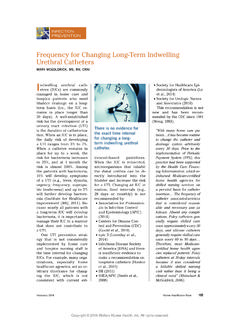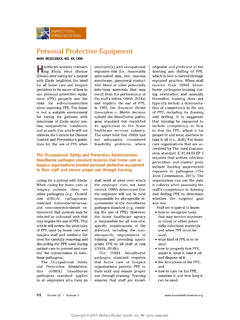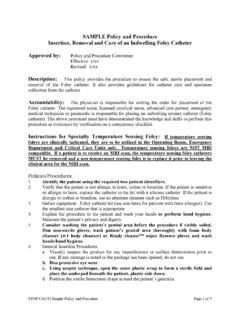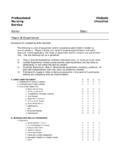Transcription of Frequency for Changing Long-Term Indwelling …
1 INFECTION PREVENTIONF ebruary 2016 Home Healthcare Now 105denced-based guidelines. When the IUC is reinserted, microorganisms that inhabit the distal urethra can be di-rectly introduced into the bladder and increase the risk for a UTI. Changing an IUC at routine, fixed intervals ( , 28 days or monthly) is not recommended by: Association for Profession-als in Infection Control and Epidemiology [APIC] (2014) Centers for Disease Con-trol and Prevention (CDC) (Gould et al.)
2 , 2010) epic 3 (Loveday et al., 2014) Infectious Disease Society of America [IDSA] and there is insufficient evidence to make a recommendation on Long-Term catheters (Hooton et al., 2010) IHI (2011) SHEA/APIC (Smith et al., 2008) Society for Healthcare Epi-demiologists of America (Lo et al., 2014) Society for Urologic Nurses and Associates (2010)This recommendation is not new and has been recom-mended by the CDC since 1981 (Wong, 1983). With many home care has become routine to change the catheter and drainage system arbitrarily every 30 days.
3 Prior to the implementation of Periodic Payment System (PPS), this practice had been supported by the Health Care Financ-ing Administration, which re-imbursed Medicare-certified home health agencies for skilled nursing services on a per-visit basis for catheter The Frequency of catheter associated-services that is considered reason-able and necessary was as follows: Absent any compli-cations, Foley catheters gen-erally require skilled care once approximately every 30 days, and silicone catheters generally require skilled care once every 60 to 90 Therefore, most Medicare-certified home health agen-cies replaced patients Foley catheters at 30-day intervals because it was considered a billable skilled nursing visit rather than it being a clinical need (Rhinehart & McGoldrick, 2006).
4 Frequency for Changing Long-Term Indwelling Urethral CathetersMARY MCGOLDRICK, MS, RN, CRNII ndwelling urethral cath-eters (IUCs) are commonly managed in home care and hospice patients who need bladder drainage on a Long-Term basis ( , the IUC re-mains in place longer than 30 days). A well-established risk for the development of a urinary tract infection (UTI) is the duration of catheteriza-tion. When an IUC is in place, the daily risk of developing a UTI ranges from 3% to 7%.
5 When a catheter remains in place for up to a week, the risk for bacteriuria increases to 25%, and at 1 month the risk is almost 100%. Among the patients with bacteriuria, 10% will develop symptoms of a UTI ( , fever, dysuria, urgency, Frequency , suprapu-bic tenderness) and up to 3% will further develop bactere-mia (Institute for Healthcare Improvement [IHI], 2011). Be-cause nearly all patients with a Long-Term IUC will develop bacteriuria, it is important to manage their IUC in a manner that does not contribute to a UTI prevention strat-egy that is not consistently implemented by home care and hospice nursing staff is the time interval for Changing IUCs.
6 For example, many orga-nizations, especially home healthcare agencies, set an ar-bitrary timeframe for chang-ing the IUC, which is not consistent with current evi-There is no evidence for the exact time interval for Changing a Long-Term Indwelling urethral 2016 Wolters Kluwer Health, Inc. All rights Volume 34 | Number 2 an IUC is still considered a Medicare-covered service, but the home healthcare agency is no longer reimbursed on a per-visit basis, yet the prac-tice of replacing the catheter every 28 to 30 days has contin-ued.
7 There is no evidence for the exact time interval for Changing a Long-Term IUC. IUCs should be changed according to the:1. Physician ordered time in-terval ( , based on the patient s usual pattern of catheter care, if any, rather than waiting for complica-tions to occur);2. Patient s clinical condition and nursing staff s evalua-tion of catheter-associated problems and complica-tions, such as leakage, obstruction from encrusta-tions, and infection;3. Dwell time prior to obtaining a urine specimen;4.
8 Incidence of a break in asep-tic technique during cath-eter insertion; and5. Manufacturer s instructions for use, if an infection occurs fre-quently or obstruction is com-mon, the IUC should be changed more often (Tenke et al., 2008).The IDSA (Hooton et al., 2010) recommends that cath-eters be changed prior to the collection of a urine specimen for a suspected catheter-asso-ciated urinary tract infection (CAUTI) if the IUC has been in place for 2 weeks or longer at the onset of the CAUTI (and the IUC is still needed).
9 After an Indwelling catheter has been in place for some time, biofilms develop and as a re-sult, a urine culture obtained from a patient whose indwell-ing catheter has a biofilm may not accurately reflect the bac-teriology of bladder urine (McGoldrick, 2015).Another recommended indi-cation for catheter replacement is when the closed system is compromised (Gould et al., 2010). Some ambulatory home care patients transfer to a leg bag for urine containment dur-ing the day, which results in a breach of the closed urinary drainage system.
10 When possi-ble, breaching the closed uri-nary system is to be IUC should remain in place only as long as the reason for insertion is still present. However, managing patients Long-Term IUCs will continue to be a routine service provided by home care and hospice nurses and we need to base our patient care practices on evi-denced-based data whenever possible. Mary McGoldrick, MS, RN, CRNI, is a Home Care and Hospice Consultant, Home Health Systems, Inc.











